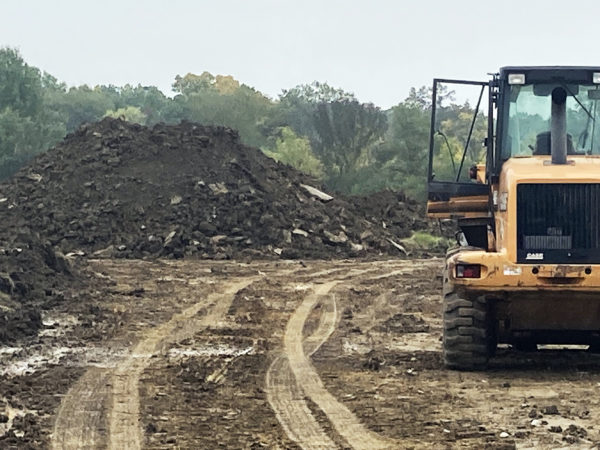
This story is a part of “A Year in the Wild Kitchen of the Great Lakes,” a series in partnership with expert forager, Lisa M. Rose with the mission of nurturing a deeper connection with the natural world through foraging. To get started with your foraging journey, begin here with our “Framework to Sustainable and Safe Practices.”
Summer in the Great Lakes region is a magical time, with long, warm days and the sweet taste of freshly picked berries. For those who know where to look, the forests, fields, and trails of this region offer a bounty of nature’s treasures: mulberries, serviceberries, wild strawberries, raspberries, wild blueberries and blackberries. Use this as your guide to gathering these sweet jewels, and then bring them into the kitchen for a Great Lakes Wild Berry pie — a culinary delight that captures the essence of a wild, foraged Great Lakes summer.
Mulberries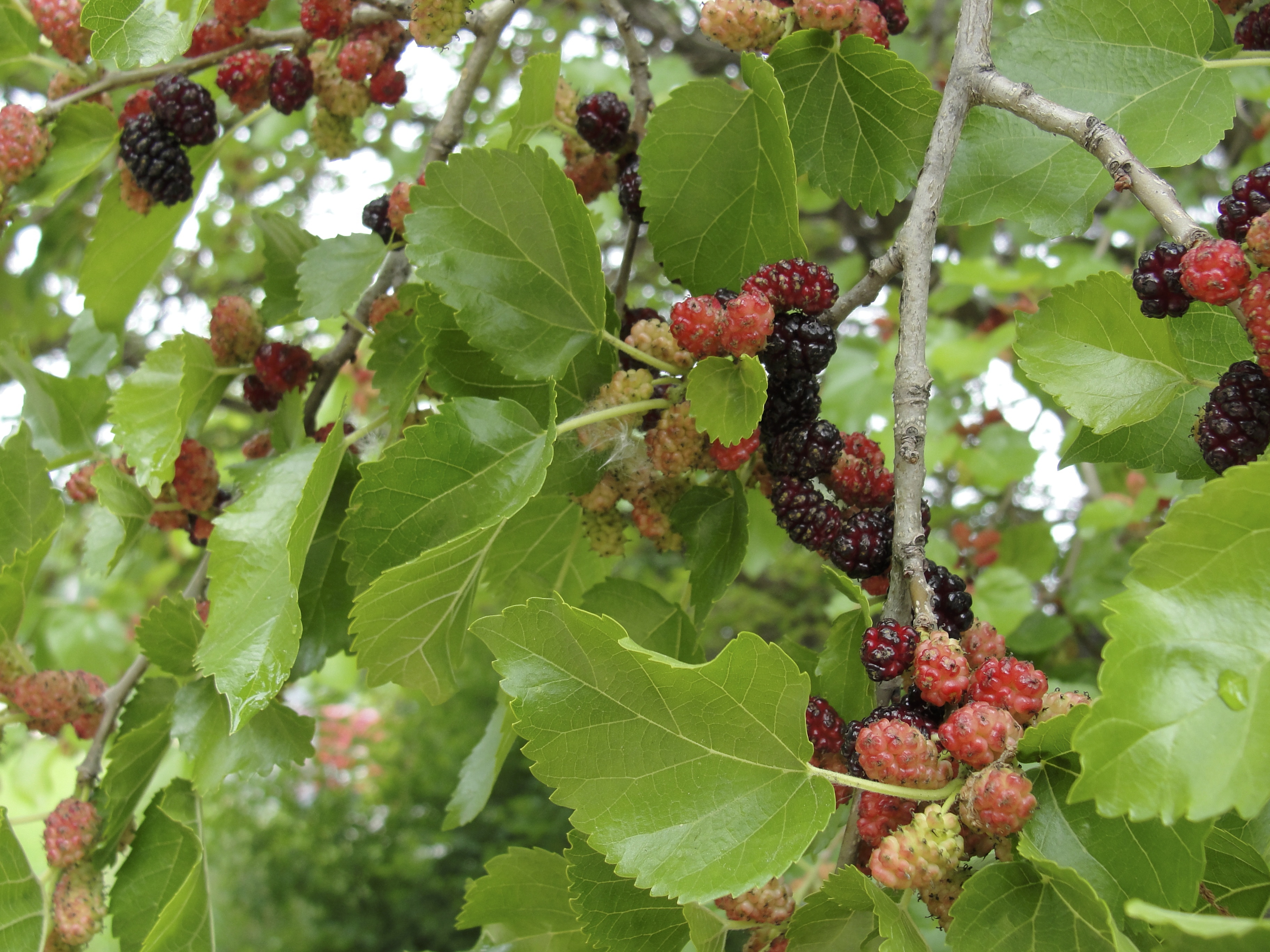

Mulberry fruit hanging heavy on the tree. (Photo Credit: Lisa M. Rose)
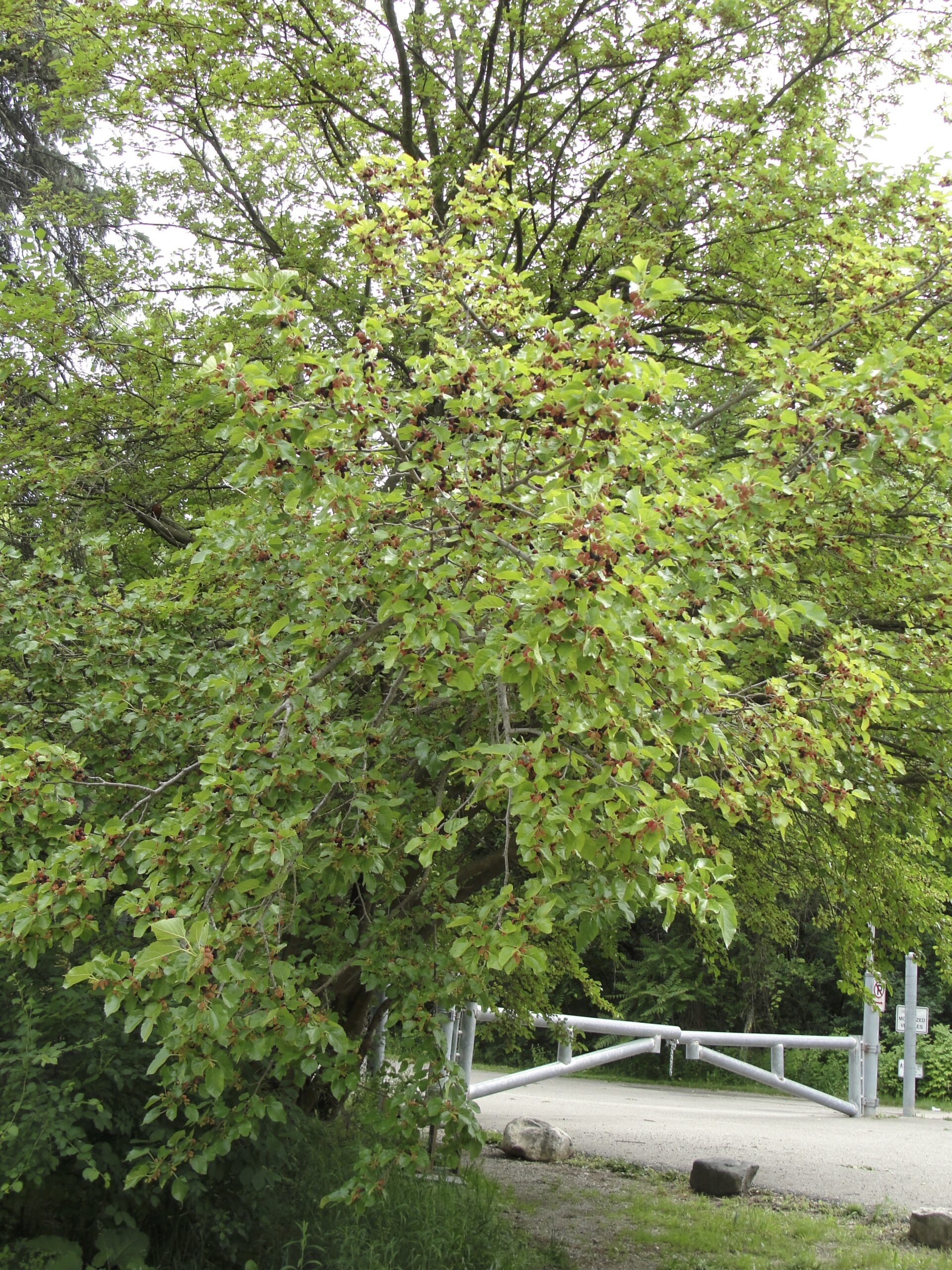
Mulberry trees grow abundantly across cityscapes. (Photo Credit: Lisa M. Rose)
Morus alba, M. rubra
Edible parts: Berries
The adventure begins in early summer when the mulberries are ripe for picking. These berries, often found on small trees in urban areas and along trails, are the first to ripen. Their mild flavor and abundant harvest make them a staple for any berry forager. Though not as sweet or tart as the other berries, they add a subtle, cooling note to the pie. The mulberry trees, often overlooked, offer their bounty without fanfare. The dark and juicy berries are a testament to the hidden treasures of the city.
How to Identify: Mulberry is often most noticed as a small tree about 25 to 30 feet tall (though it can grow as tall as 70 feet). Its young bark ranges from yellowish-brown to orangish-brown with scattered large white lenticels, which are the raised pores of a tree that look like little stretch marks. Older bark is brown and ridged with an occasional glimpse of orange inner bark. If the roots are unearthed by erosion or contraction, you will see that they are distinctively orange.
The leaves of both species are alternate, simple, more or less heart-shaped, and palmately veined with three main veins; they have rounded teeth along the edges. Both white and red mulberry trees may have mitten-shaped leaves. Leaves of white mulberry (Morus alba) are dark and shiny on top and feel smooth. Those of red mulberry (M. rubra) are not shiny and feel rough. Its fruits are longer, juicier, and better tasting than the white.
Where and When to Gather: White mulberry is a common ornamental planting in gardens, courtyards, and municipal parks, and it has naturalized in some areas. Red mulberry is commonly found at the edge of the woods and along trails in partial sun and shade. Around the summer solstice, the juicy fruits of the mulberry can cause a mess wherever they fall, staining everything they touch with their black juice.
Serviceberries

Serviceberry fruit, ripening on the tree. (Photo Credit: Lisa M. Rose)
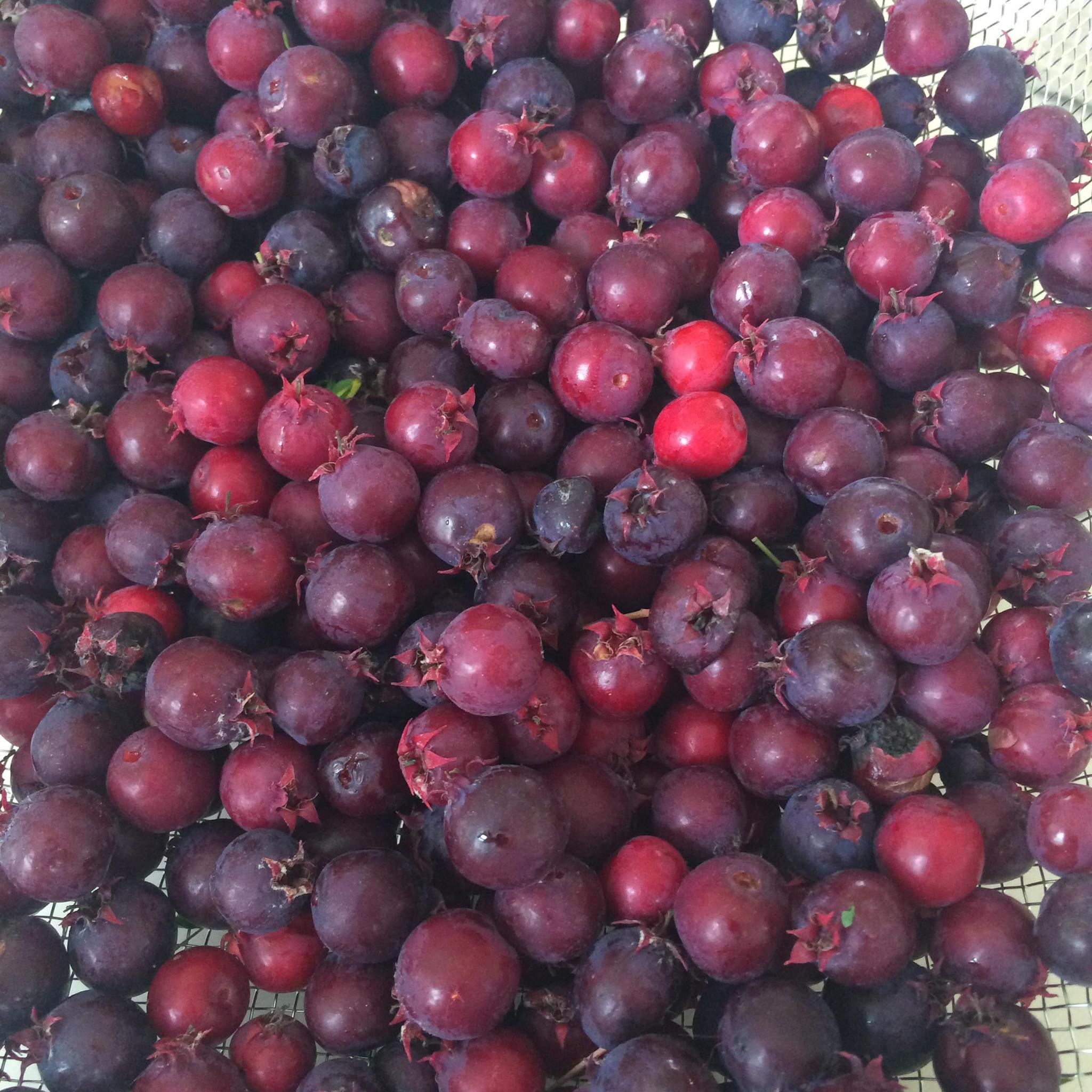
Serviceberry harvest, ready for pie. (Photo Credit: Lisa M. Rose)
Amelanchier species
Edible parts: Berries
By mid-June, the serviceberries are ready. These berries, with their sweet, balanced flavor, are found in hedgerows and open woodlands. The small, dark purple fruits are easy to gather and make a delightful addition to the berry medley. Their flavor, a cross between a cherry and a blueberry, pairs perfectly with the other berries in the pie.
How to Identify: Serviceberry is a small, fruiting, deciduous shrub or small tree that grows to a height of 20 feet. Its bark is smooth gray with dark vertical furrows. The leaves are oval, serrated, smooth or slightly hairy, and alternate along the stem. The white, five-petaled flowers bloom in early spring, and dark purple fruit in racemes ripens in midsummer. Each fruit has a small crown at the base, similar to an apple or pear.
Where and When to Gather: Serviceberry is found in the wild along hedgerows and in open woodlands. It is a common landscape plant whose fruits usually go unnoticed. The berries ripen in mid- to late June.
Wild Strawberries
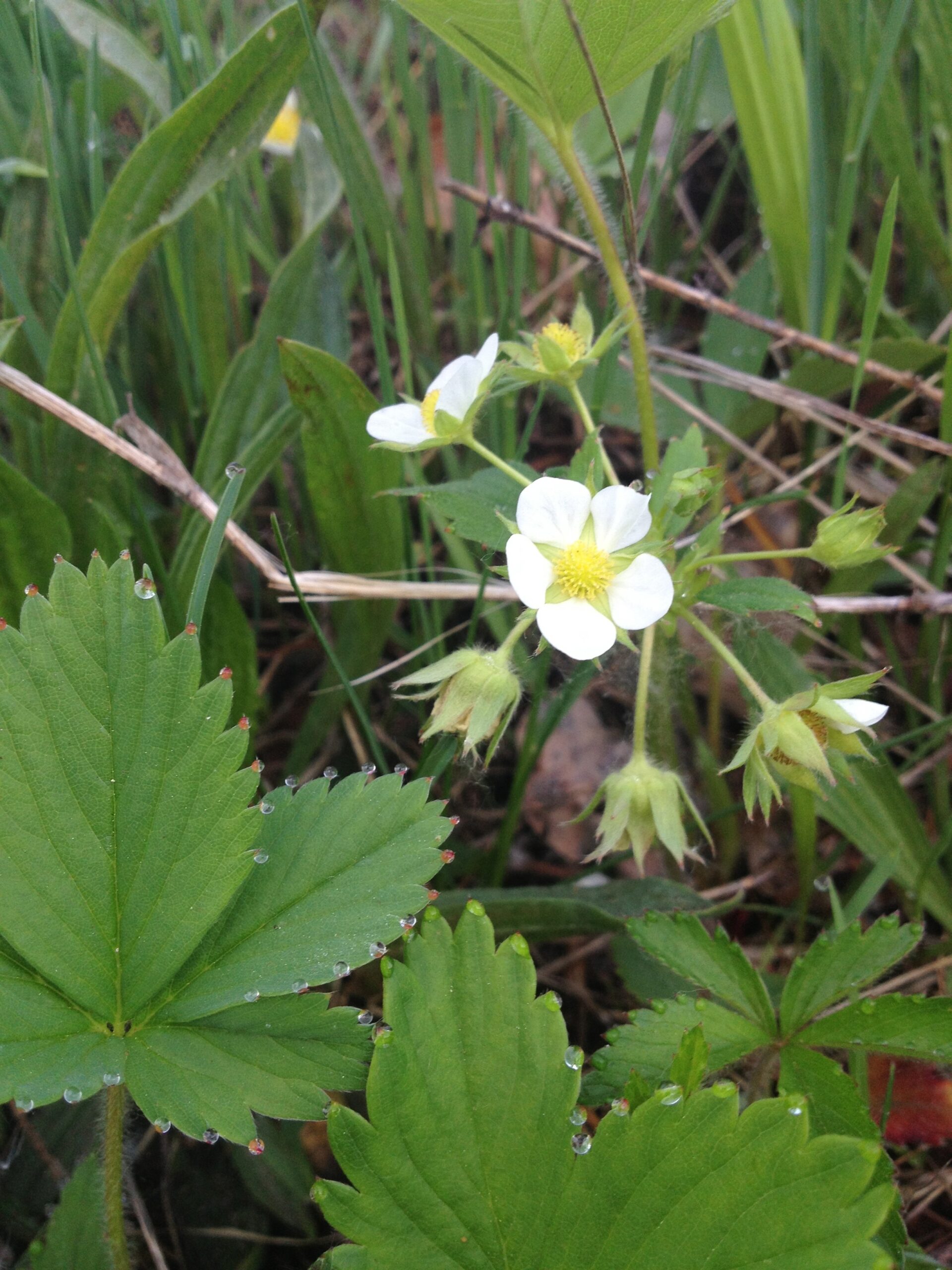
Wild strawberry plant featuring flowers. (Photo Credit: Lisa M. Rose)
Fragaria species
Edible parts: Berries
The hunt for wild strawberries begins around the summer solstice. These tiny, intensely flavored berries are a true treasure of the Great Lakes summer. Found in open fields and meadows, the wild strawberries are a labor of love to collect but are well worth the effort. The small, red berries, hidden among the grass, require patience and a keen eye. Each one, a ruby-red gem, is a reward for the diligent forager. The taste, sweet and intense, is a reminder of summer’s fleeting beauty.
How to Identify: Wild strawberry is a low-growing, herbaceous plant with toothed, three-part leaflets at the end of a hairy, slender stem. The white flower clusters begin to bloom in late spring and give way to small, red strawberry fruit in early summer. The leaves remain on the plant through the fall and turn a deep red color in autumn, helpful for off-season identification.
Where and When to Gather: Wild strawberries can be found in open fields and meadows; moist, well-drained soils of hedgerows; and along the edges of the wood, oftentimes in tall grasses. The berries ripen about the same time as the summer solstice. Finding a patch large enough for a big harvest can be tough, but it’s worth the effort of seeking out (and then certainly keeping a secret).
Raspberries

Red raspberries on the bush. (Photo Credit: Lisa M. Rose)
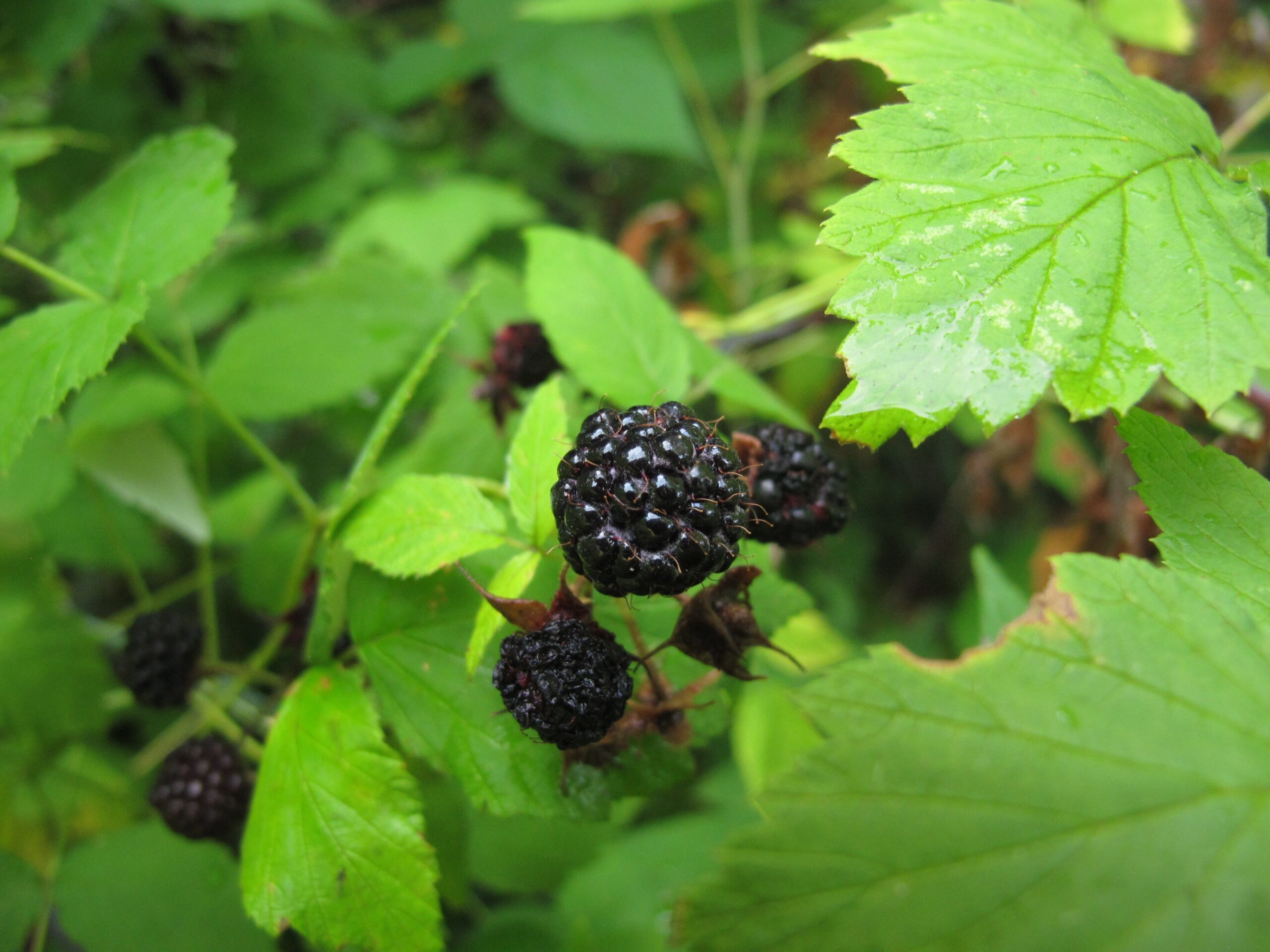
Black raspberries are common on trails across the Great Lakes. (Photo Credit: Lisa M. Rose)
Rubus idaeus, R. occidentalis
Edible parts: Berries, leaves, root
Next, it’s time to seek out the raspberry patches. Both red and black raspberries grow abundantly at the edges of woodlands and along trails. Black raspberries, with their deep color and intense sweetness, are ready for picking by early July. Raspberries — both red and black — are a favorite summer fruit. Whether enjoyed by the handful trailside while walking to the beach or gathered for a summer fruit pie, the raspberry is easy to identify and a must-gather for the forager.
How to Identify: The thorny canes of red (Rubus idaeus) and black (Rubus occidentalis) raspberry are sprawling and grow in large stands at the edges of the woodlands. The leaves are toothed with pointed ends, grow alternately in leaflets of three to five along the canes, and are green with a silvery underside. Raspberry flowers in late spring. Black raspberries ripen in midsummer, while red raspberries ripen in late summer to early fall.
Where and When to Gather: The raspberry is a native woodland plant found at the edges of the woods, trails, hedgerows, and ditches. The leaves can be gathered for tea in early spring and late fall.
Blueberry

Bowl of fresh, wild blueberries served warm with cream. (Photo Credit: Lisa M. Rose)
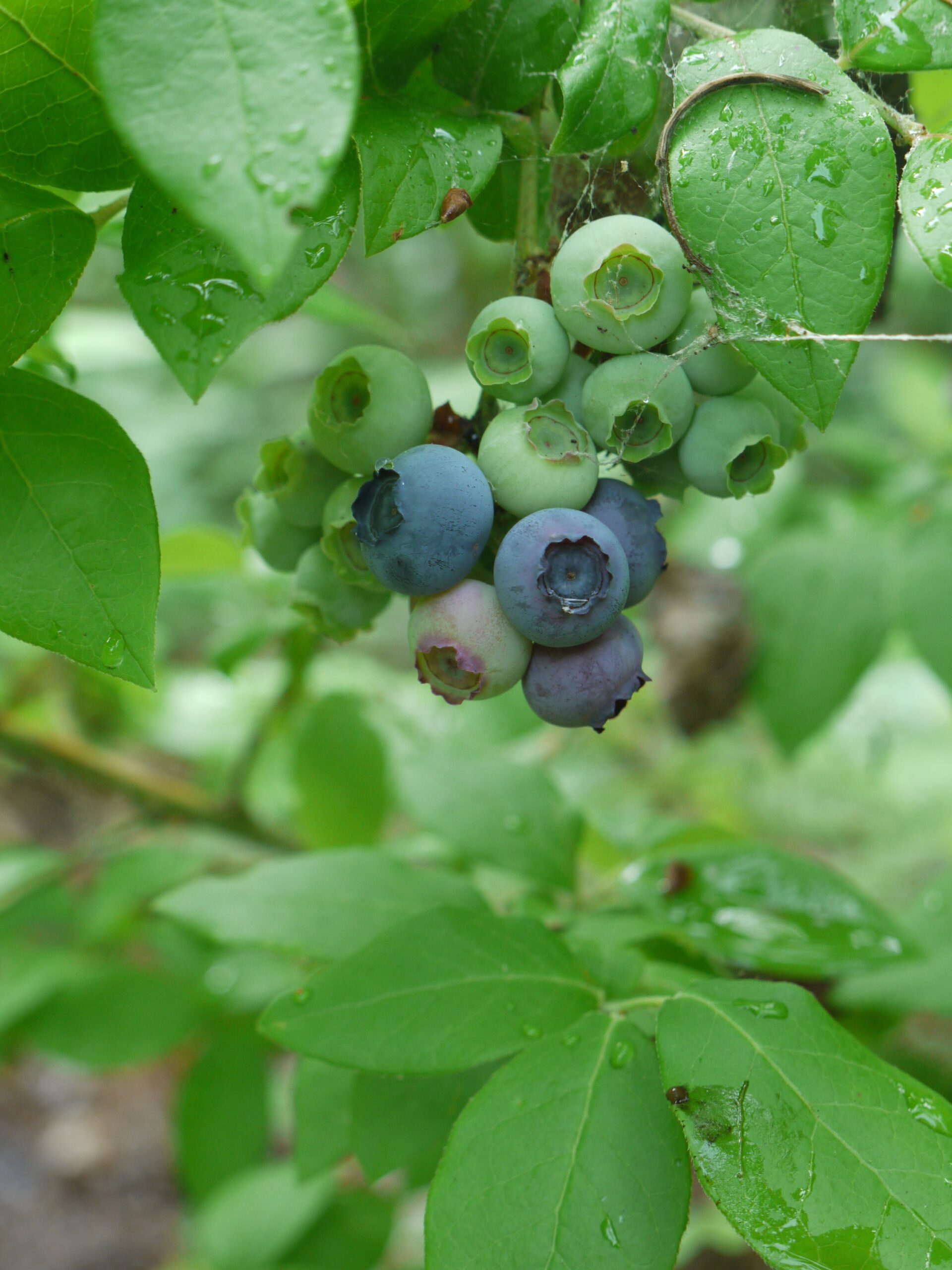
Wild blueberry fruits on the trail. (Photo Credit: Lisa M. Rose)
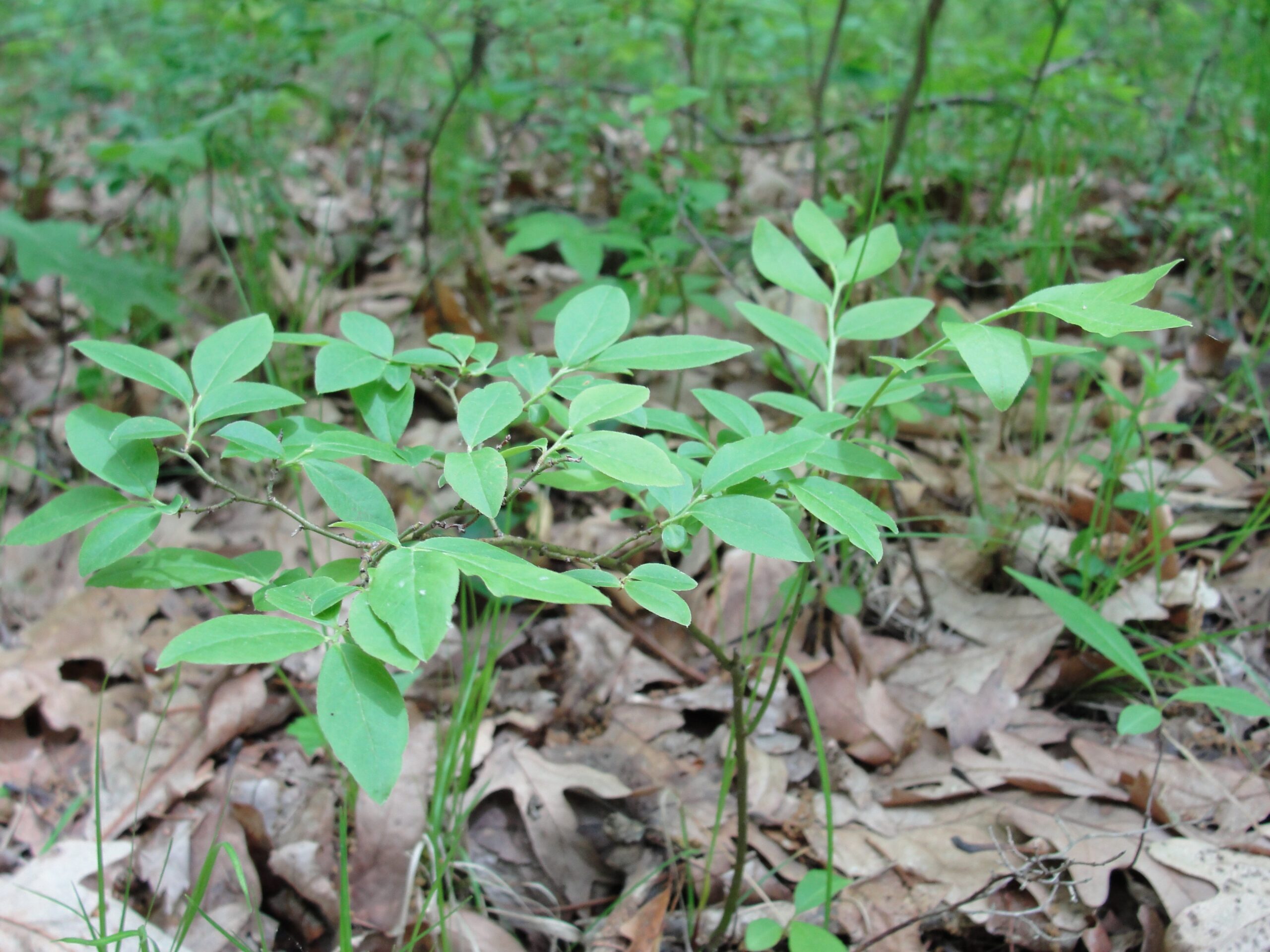
Wild blueberries are low growing on the trail. (Photo Credit: Lisa M. Rose)
Vaccinium species
Edible parts: Berries
Wild blueberries are some of the most delicious berries to harvest in the summer. Found along the edges of the woodland, bogs, and open fields in July and early August. Fair warning, you may want mosquito protection as you head out to gather these delights! Picking berries by hand will guarantee a cleaner pick than with a harvest rake, which will also invariably pull in unwanted twigs, bugs, debris, and undesirable fruit. Time saved in the field with the rake is lost to sorting in the kitchen.
How to Identify: Blueberries grow in colonies. Species vary in height, ranging from small 6 to 8 inch ground cover in the woods to a towering, deciduous shrub of more than 10 feet in open fields and bogs. All berries in the genus Vaccinium are edible and interchangeable in use. The bark of the blueberry is mostly gray and can sometimes have a bit of green or even pink along the woody stems. The leaves vary in size, but are 1 to 2 inches long, ovate, and simple, with smooth to slightly toothed edges. The whitish pink flowers bloom in late spring and give way to the delicious fruits that ripen in mid- to late summer.
Berries are blue to nearly black and can range in size from 1/4 to 3/4 inch in diameter, borne singly or in small clusters. The berry’s sweetness is both species and season dependent. Smaller berries have a tendency to be more sour than the large varieties, and weather has an effect on the plumpness of the berry.
Where and When to Gather: The wild blueberry harvest peaks in August. Seek out wild blueberries in bogs and in sunny open fields. When you discover a wild blueberry stand, be ready for an abundance of picking.
Blackberries
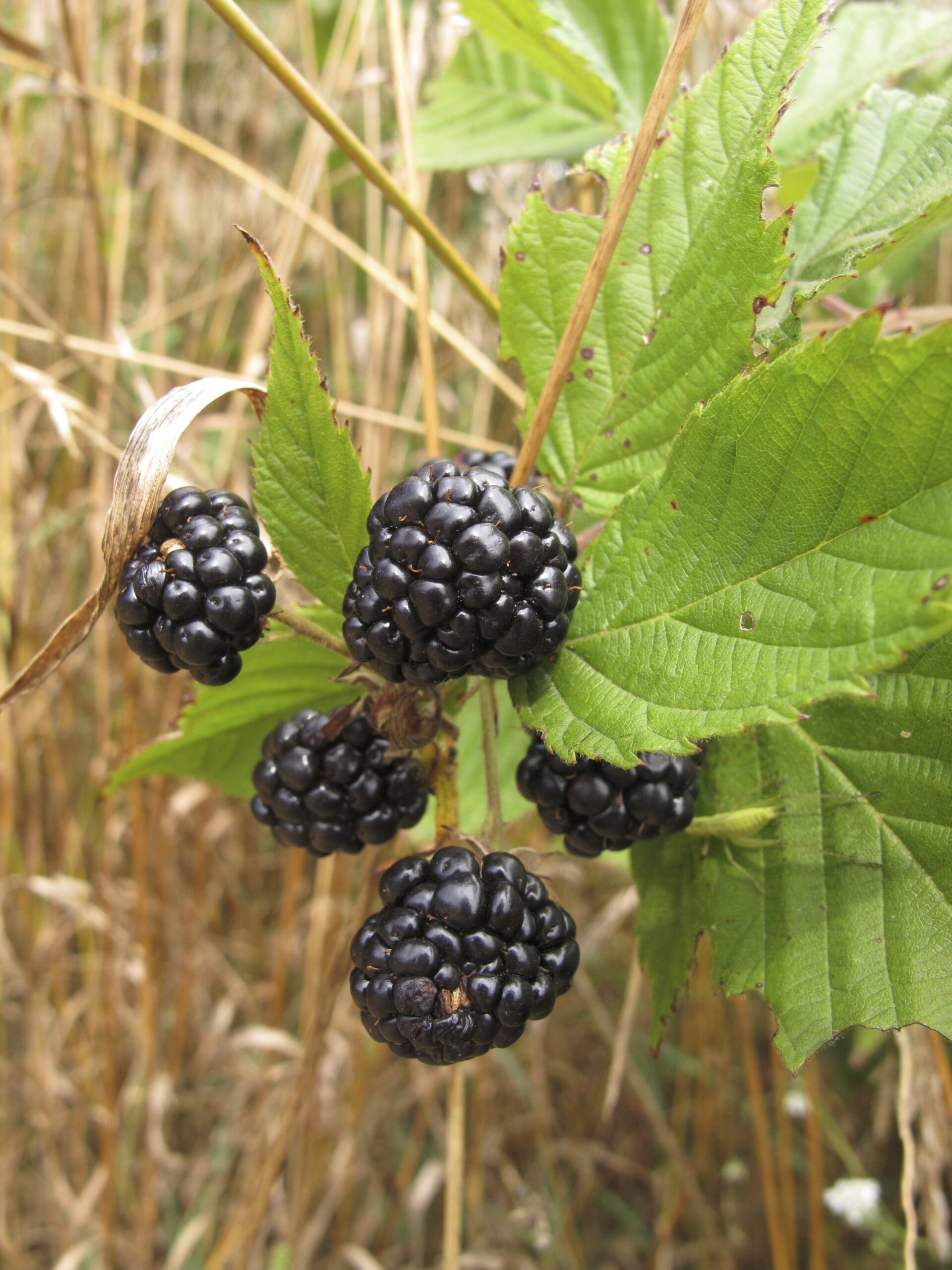
Wild blackberries in summer. (Photo Credit: Lisa M. Rose)
Rubus species
Edible parts: Berries, leaves, roots
The adventure continues into mid-July when the sun is high and the blackberries are ripe for picking. Armed with pails and protective gloves to fend off the prickly thorns, foragers venture into the sunny edges of the woods. The blackberry bramble, a sprawling plant covered in thorns, hides clusters of dark, juicy berries that are perfect for a summer pie. The dark, jammy fruit of the blackberry is a forager’s favorite midsummer find along a sunny trail. The plant offers an abundance of food: its leaves and roots can be used for tea, and the berry makes delicious eating.
How to Identify: Common in sandy, well-drained soils, blackberry is usually found as a large stand of plants in the sun on the edges of the wood. A bramble of a plant reaching heights to 5 feet, the blackberry is covered in thorns; its divided leaf clusters hold three to five serrated and ovate leaflets which have a prickly midrib. The blackberry blooms in late spring with white, five-petaled flowers that bear seedy, slightly hairy fruit that ripens into dark purple berries in late summer.
Where and When to Gather: The leaves can be gathered in early spring for tea, and the berries can be gathered by the bucketful in mid- to late summer. If you harvest the root, wait until fall when the plant begins to die back after harvest.
Great Lakes Wild Berry Pie

Great Lakes Wild Berry Pie. (Photo Credit: Lisa M. Rose)
This wild berry pie is designed to highlight the best of the Great Lakes wild berries that can be found across the summer. Given the variety of berries will vary based on the time of the season, the ingredients list below can be adjusted to what you have in your berry basket. A pro-tip? Freeze your findings from June through August so at any time you can blend together this amalgam of delicious berries for the ultimate Great Lakes Wild Berry Pie.
Ingredients:
- 1 cup mulberries
- 1 cup serviceberries
- 1 cup wild strawberries
- 1 cup raspberries
- 1 cup blueberries
- 1 cup blackberries
- 1 cup granulated sugar
- 1/4 cup brown sugar
- 1/4 cup cornstarch
- 1/2 teaspoon ground cinnamon
- 1/4 teaspoon ground nutmeg
- 1 tablespoon lemon juice
- 2 tablespoons unsalted butter, cut into small pieces
- 1 package (14 ounces) refrigerated pie crusts (or homemade pie crust)
- 1 egg, beaten (for egg wash)
- 1 tablespoon coarse sugar (optional, for topping)
Instructions:
- Preheat Oven: Preheat your oven to 375°F (190°C).
- Prepare the Berries: In a large bowl, combine the mulberries, serviceberries, wild strawberries, raspberries, and blackberries. Gently toss to mix.
- Mix the Filling: In a separate bowl, combine the granulated sugar, brown sugar, cornstarch, ground cinnamon, and ground nutmeg. Sprinkle this mixture over the berries and gently toss to coat. Add the lemon juice and toss again.
- Prepare the Pie Crust: Roll out one pie crust and fit it into a 9-inch pie plate. Trim the edges, leaving about 1/2 inch overhang.
- Fill the Pie: Pour the berry mixture into the prepared pie crust. Dot the top of the berries with the small pieces of butter.
- Top Crust: Roll out the second pie crust and place it over the berry filling. Trim the edges to about 1/2 inch overhang and tuck the top crust under the edge of the bottom crust. Crimp the edges to seal. Cut a few slits in the top crust to allow steam to escape.
- Egg Wash: Brush the top crust with the beaten egg. Sprinkle with coarse sugar if desired.
- Bake: Place the pie on a baking sheet to catch any drips and bake in the preheated oven for 45-55 minutes, or until the crust is golden brown and the filling is bubbly.
- Cool: Remove the pie from the oven and let it cool on a wire rack for at least 2 hours before serving. This allows the filling to set.
Serving Suggestions: Serve the mixed wild berry pie warm or at room temperature. It pairs beautifully with a scoop of vanilla ice cream or a dollop of whipped cream.
About the Author
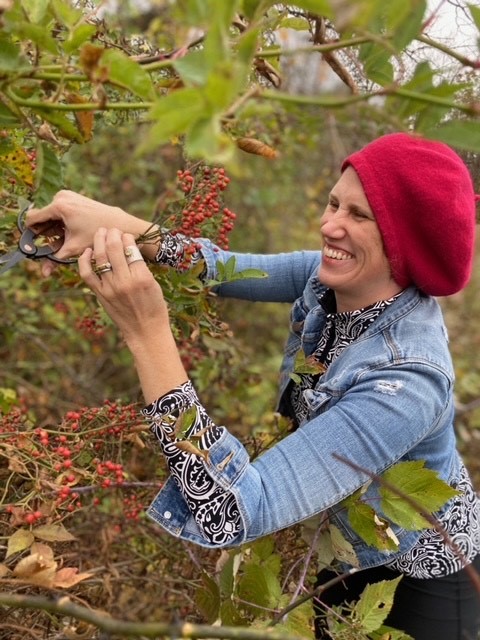
Lisa M. Rose is an ethnobotanist, wild foods chef, and author with a profound dedication to exploring the symbiotic relationship between humans and plants. With an academic background in anthropology and community health, her culinary journey has been rich and varied, including stints with notable establishments and figures such as Stags Leap in Napa Valley, Alice Waters’ The Edible Schoolyard, and organic farmers in Northern Michigan.
Rose’s work is celebrated in her bestselling books, “Midwest Foraging” and “Midwest Medicinal Plants,” among others and her expertise is frequently sought by major media outlets, including the Chicago Tribune, PBS, NPR, Martha Stewart and CNN.
Catch more news at Great Lakes Now:
Cornish Roots & Nettle Shoots: A Foraged Pasty Recipe from Michigan’s Upper Peninsula
Foraging’s Spring Backyard Splendor: Dandelions and Violets
Featured image: Raspberries fresh for the eating. (Photo Credit: Lisa M. Rose)


